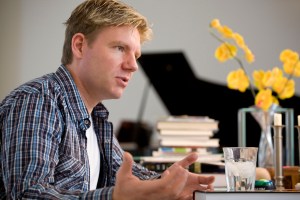
Lomborg in 2007 (AP Photo)
Yesterday the Guardian reported that Bjorn Lomborg, the Danish scientist with the shock of blond hair who made a name for himself decrying the world’s hysteria about climate change, makes a surprising claim in his upcoming book – that confronting climate change should be a global priority, and that a $100 billion per year investment could solve the crisis by the end of the century.
That sounds a little counterintuitive coming from the author of The Skeptical Environmentalist and Cool It: The Skeptical Environmentalist’s Guide to Global Warming. But Lomborg, who was on the TIME 100 list of the world’s most influential people in 2004, has never said that global warming is a hoax, as have some of the conservative voices his views have been aligned with. What Lomborg has argued is that while climate change is real, it is not the catastrophe it has been depicted by some scientists to be, and the world would be better off adapting to it than continuing to spend money on cutting carbon emissions while ignoring other high global priorities, like finding a cure for malaria or ending hunger.
In a 2007 interview after his second book came out, Lomborg told TIME:
Obviously, in a perfect world we should fix all problems. We should fix climate change, and, preferably, tomorrow. We should also stop HIV/AIDS, malaria, malnutrition, and give clean water and sanitation to everyone, stop all civil wars. There are a lot of things in principle we should do, and I agree with all of those.
But, of course, we don’t. We’ve had most of these problems for 50 years and we haven’t fixed all of them. It seems reasonable to me to have a conversation: If we don’t fix all problems tomorrow, can we at least talk about where we could do the most good first? Not ignoring the fact we should be doing all these things — but since we aren’t, shouldn’t we have a conversation about whether we can do lots of good or a little good?
(Watch video excerpts from that interview here.)
Lomborg’s new book, Smart Solutions to Climate Change: Comparing Costs and Benefits, puts global warming higher on that theoretical list. Lomborg told the Guardian that he amended his thinking after the last Copenhagen Consensus in 2008, a project that asks a group of economists how $75 billion (the approximately total of foreign aid budgets) should be spent to most efficiently improve life on earth.
The first Consensus in 2004 placed the costly policy of developing a carbon tax to cut emissions at the bottom of the list, under things like fighting HIV/Aids. But in the project’s second round in 2008, economists ranked a variety of approaches to mitigating global warming higher. Considering these new approaches, Lomborg said, caused him to rethink how global warming spending could be effectively applied.
From the Guardian:
The difference was made by examining not just the dominant international policy to cut carbon emissions, but also seven other “solutions” including more investment in technology, climate engineering, and planting more trees and reducing soot and methane, also significant contributors to climate change, said Lomborg.
Many have argued that the Consensus’ methods are off base, as neither human lives nor some of the wider effects of climate change can be valued in stark economic terms. Lomborg’s critics have also long said that the statistician’s work makes contradictory claims and uses numbers out of context to paint climate change as a less serious threat than it is. They will undoubtedly find fault, too, in the apparent about face Lomborg takes in his latest tome, but the Dane insists that he’s been arguing the same basics all along.
In any case, Lomborg skeptics needn’t fret – he hasn’t exactly made any effort to steer clear of controversy. With his newfound enthusiasm for putting R&D money into now widely unpopular climate engineering methods, such as “cloud whitening” to reflect heat back up to the sun, he is sure to give them plenty of new material to work with.


